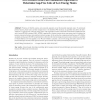45 search results - page 3 / 9 » Inferring modules of functionally interacting proteins using... |
COMPLIFE
2005
Springer
13 years 10 months ago
2005
Springer
Abstract. We describe an approach to clustering the yeast protein-protein interaction network in order to identify functional modules, groups of proteins forming multi-protein comp...
JCC
2007
13 years 4 months ago
2007
: Proteins are flexible systems and commonly populate several functionally important states. To understand protein function, these states and their energies have to be identified...
BMCBI
2006
13 years 4 months ago
2006
Background: Sequence comparison is one of the most prominent tools in biological research, and is instrumental in studying gene function and evolution. The rapid development of hi...
BIBM
2008
IEEE
13 years 11 months ago
2008
IEEE
The study of gene function is critical in various genomic and proteomic fields. Due to the availability of tremendous amounts of different types of protein data, integrating thes...
BMCBI
2008
13 years 4 months ago
2008
Background: Prediction of disulfide bridges from protein sequences is useful for characterizing structural and functional properties of proteins. Several methods based on differen...

